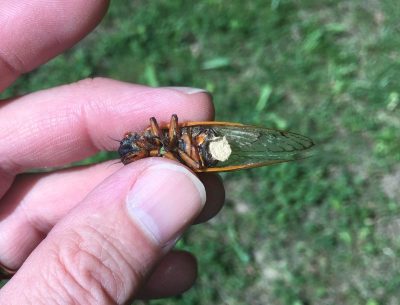
Periodical cicadas are subject to infection by the specialized fungal parasite Massospora cicadina Peck (Speare 1919, Marlatt 1923). Infection follows a predictable phenology. Early in a periodical cicada emergence “Stage I”, infected cicadas produce conidia capable of infecting other adult cicadas (Speare 1921, Soper 1974, Soper et al. 1976). Later in the emergence “Stage II” cicadas infected by conidiospores produce resting spores that complete the fungal life cycle by infecting the next generation of cicada nymphs that will emerge from the soil 13 or 17 years later (Soper et al. 1976, Duke et al. 2002).
The most amazing thing about the fungus? It turns infected cicadas into “zombie insects” that disperse more fungus by causing males infected with Stage I to produce wing-flick signals as if they were females– making them highly attractive to cicadas of both sexes (Cooley et al. 2018)! This example is unusual in the “zombie insect” literature in that infected cicadas are co-opted to become active spore dispersers while they are still alive; many similar host-parasite systems accomplish dispersal only once the host is dead. Furthermore, Massospora also produces powerful psychoactive chemicals whose function is not well understood (Boyce et al. 2019).
This video describes the fungus life cycle and how it turns cicadas into “zombie insects.”